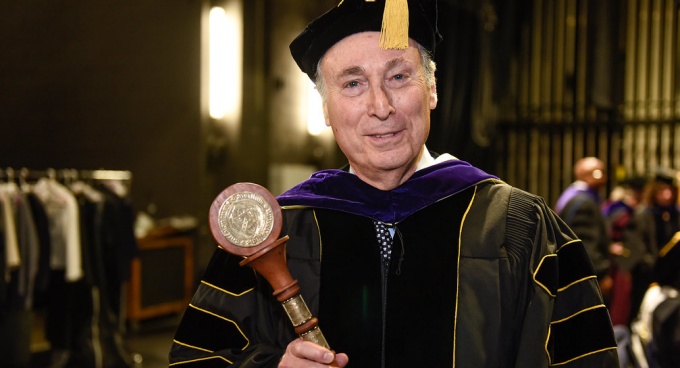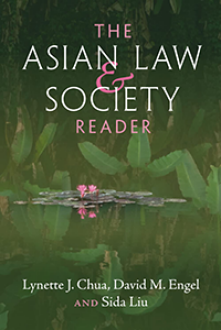
Taking his teaching global
When he stepped down from full-time teaching in 2019, David M. Engel, SUNY Distinguished Service Professor Emeritus, had already embarked on what he calls his retirement project: a series of biannual workshops to train Law and Society scholars in Asia.

Purchase The Asian Law and Society Reader at Cambridge University Press.
That project, called TRIALS (Training Initiative for Law and Society Scholars) and based at the National University of Singapore, is thriving, and now Engel has also published The Asian Law and Society Reader (Cambridge University Press). The co-edited volume gathers recent scholarship from leading Asia-based scholars in Law and Society, a research approach that looks at the place of law in social, political, economic and cultural life. It’s the first collection of Law and Society scholarship featuring that entire region.
Engel is fully invested in this approach to the study of law; he’s a former president of the Law & Society Association and serves as a founding co-editor of the Asian Journal of Law and Society.
UB Law Links spoke with Engel from his home in California, on the eve of yet another trip to Singapore, and asked him to elaborate on his intellectual life in retirement.
Congratulations on the publication of The Asian Law and Society Reader. Given that this is a developing field in Asian scholarship, was it difficult to find enough strong contributors? How do you hope the book will be used?
Across Asia, there is a growing demand among policymakers for law-related research that goes beyond the study of legal theory and philosophy and asks how Asian legal systems actually work. My co-authors, Lynette Chua and Sida Liu, have been key figures in addressing this need. We’ve witnessed exciting initiatives in the training of Asian law students and a new generation of scholars eager to learn about Law and Society research in their own countries.
This reader is meant to benefit them, but it’s also designed for a general audience interested in learning more about the countries and cultures of Asia. We considered hundreds of books and articles—there were plenty to choose from—and ended up with studies of 29 countries. We also provide extensive commentaries on each topic. This book is intended as a general introduction to the field of Law and Society scholarship and to the laws, cultures and societies of Asia.
The new book’s cover image is your own photo. Can you speak to the discussions that led to that choice?
Working with Cambridge University Press to find an appropriate image for the cover raised some of the same issues that the book itself deals with. Typically, books about Asia feature images of temples or religious art or dance, but our book deals with many different religions—Hinduism, Buddhism, Islam and Christianity among them. We didn’t want to feature one religious tradition to the exclusion of others. Moreover, in some belief systems it might be offensive to portray any sentient being at all. So it became a challenge to find an image that seemed “Asian” yet was not religious and didn’t show people or animals.
We settled on a photo I had taken while walking in the mountains of northern Thailand. It shows this amazingly beautiful pond full of reflected palms and flowers and the image—and reflection—of a pink water lily. In its totality, this photograph seemed to capture some of the deeper meanings of our book.
Through your workshops in Singapore, you’ve put great energy into developing Law and Society scholarship among Asian academics. Are there aspects of Asian societies that particularly lend themselves to study through this lens?
Almost all Asian societies feature legal systems that have been transplanted from other countries, including England, France, Germany, the Netherlands, the U.S. and Russia. These foreign laws were superimposed on centuries-old legal traditions and on localized village-level customary practices. As a result, there are striking differences between the official legal system of judges, lawyers and legal scholars and the law-related practices and beliefs that are more familiar to Asian people.
Japanese legal scholars in the early 20th century were among the first to recognize the importance of these differences, and they helped to create the field of Law and Society worldwide. Many other researchers came to recognize that studying transplanted legal doctrine alone would tell them very little about the hybrid, pluralistic quality of law in Asian settings. Perhaps for that reason, scholars of Asian law have been drawn to the Law and Society field in growing numbers.
Another recent project is co-editing a compilation of U.S. and international scholars writing about the civil justice system. What draws you to this area of study, and how might this volume inform thinking about making the civil justice system more accessible to all who might have a claim?
Anne Bloom, Richard Jolly and I are preparing the Research Handbook on the Civil Justice System (Elgar Publishing) with contributions from 28 distinguished scholars based in the U.S. and in other countries. All of them are concerned with how and whether legal institutions offer meaningful remedies for individuals who seek justice when their rights are infringed.
My own interest draws on my four decades as a torts professor and on my interviews with hundreds of individuals who have been injured or whose civil rights have been violated yet feel hopeless when it comes to seeking help from the legal system. The task of making the civil justice system more accessible may be a bit like pushing the same boulder repeatedly up the mountain, yet the authors contributing to this volume have never given up hope.
Your book The Myth of the Litigious Society: Why We Don’t Sue has drawn the attention of, among others, Ralph Nader, who recently invited you to present in a panel discussion he chaired. What if anything has changed in Americans’ attitudes toward the tort system since its publication in 2016?
Americans will always have an ambivalent attitude toward the tort system. They will cheer Erin Brockovich for fighting the system on behalf of the little guy, but ridicule Saul Goodman for trying to convert human misfortune into big bucks. I don’t expect that to change.
But there has been a gradual shift. We don’t see the strident anti-tort PR campaign featured quite so prominently in political contests, and there has been more of an effort to educate the public on the essential benefits injury law confers in every legal system in the world. There was even a documentary film, Hot Coffee, about the real facts in the McDonald’s coffee case. Ralph Nader in recent years has turned his attention increasingly toward public education – that was the purpose of the panel in which I took part. Different views on tort law must be welcomed and respected, but I certainly favor informed debate over misinformation and vilification!